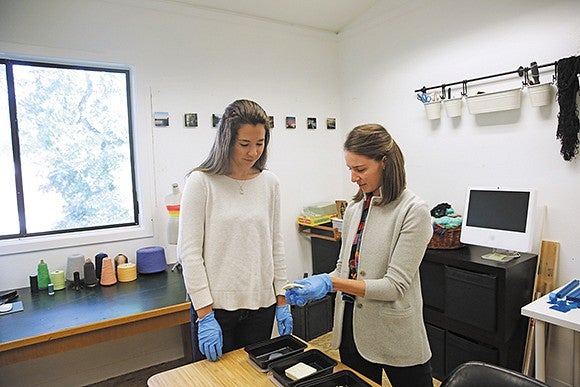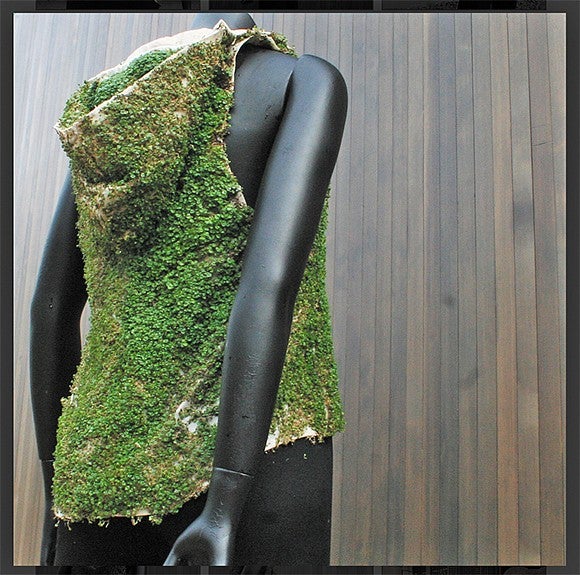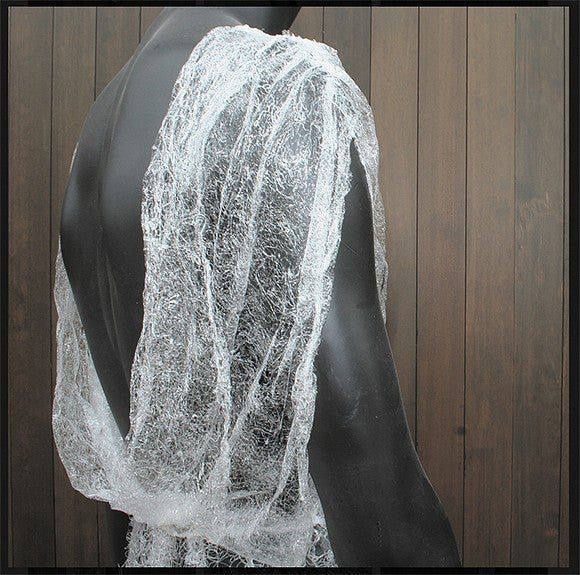Beth Esponnette made a jacket out of sprouted chia seeds and muslin, a beautiful, filmy gown from hot glue and water, and a cocktail dress—composed of alum salt crystals—that literally grew into form.
She doesn’t expect people to wear her revolutionary garments, although she admits Lady Gaga might find them appealing. Her goal is rather to get people to think about what materials they put on their bodies as well as where their clothing comes from.
“I hope these pieces affect design and how people make decisions in buying things,” says Esponnette, assistant professor of product design at the UO. “By calling on nature, and making clothing that will biodegrade and become something else, I’m trying to allude to the need for a circular process in manufacturing, instead of a linear process that ends with things being thrown out.”

Esponnette, who spans the definitions of artist, teacher, and entrepreneur, plans to directly address the rampant waste that occurs in the clothing industry through her startup—Unspun. While still in the discovery stage, her goal is to manufacture garments using “additive” manufacturing techniques based on the concept of 3-D printing.
Traditionally, clothing is made through a subtractive process: First, yarn is woven into large, flat sheets of fabric. Then, to make that into “anything that’s not a toga or a sari,” you have to cut it up, Esponnette says. “When you do that, you’re wasting about 15 percent of the fabric. That’s huge.”
The waste incurred during manufacturing is just the beginning. Soon the clothing is shipped to stores, where buyers can browse from a large array of sizes and colors. They expect to find exactly what they’re looking for, and get annoyed if they don’t. “So that means retailers have to multiply everything, just to cover their bases,” Esponnette says. “And a lot of it doesn’t sell.” If a company doesn’t care about its name, they’ll send the extra clothing to off-price retailers, but if they want to protect their brand, they destroy it. “That’s pretty terrible,” she says.
Esponnette envisions a completely different world in which clothing is made to order on a 3-D printer that builds each item straight from yarn, with no waste. She’s already completed a proof of concept, which is not an easy task considering this is a brand new technology. “But we’ve proven that the technology works, even though we don’t have any products yet,” she says. “So the next step is, okay, let’s make the next machine that makes a relevant product.”
So, while also fundraising for Unspun and teaching product design courses, Esponnette and her undergraduate research assistant are experimenting with various chemicals, particularly silicone rubbers. “For this technology, it doesn’t matter what kind of yarn it is,” she says. “It could be silk, or it could be carbon fiber. There’s a huge controversy about synthetics versus cotton, in terms of water and chemicals, but we’re not getting into that.”
Instead she’s concentrating on creating the new technology while also working with 3-D scanning to come up with ways that a person’s body measurements could be transferred directly to the printer. “In the future, that’s where we see things going,” she says. “Perhaps we’ll all have avatars online and we’ll try things on our avatar.”
She plans to start with just one product, probably with an industrial or athletic application, but due to her as-yet unpatented process, she’s not ready to reveal what it is. “It will be a really refined product that fills a strong need,” she says. “Besides the technology being good for the environment, the fact that the garments are seamless will make them stronger and more comfortable.”
Esponnette, just 28, sees her youth as an asset. “I think it really helps me to not be so ingrained in my thinking because my mind hasn’t been set in stone,” she says. “I just go for it.”
Growing up in rural Maine, Esponnette couldn’t decide whether to be an orthopedic surgeon or a fashion designer. She eventually studied fashion design at Cornell University, where she had the opportunity to research surface treatments that change the properties of fabrics. While still an undergrad, she began working with firefighters to design functional apparel. “It made me realize how much the design, fit, and construction of clothing affects the usefulness of a product,” she says. “For firefighters, it can be the difference between life or death.”

After graduating, she went to work as a designer and materials researcher in the outdoor industry. “I was proud of what people were using the products for, and what they allowed people to do,” she says, “but when you looked at the whole picture and saw all that waste, I wasn’t proud.”
So she went back to school and got an MFA in design at Stanford University. Soon after graduating, in June 2015, she started Unspun with two friends, one with an MBA and the other with an engineering degree. “What we’re trying to do is localize manufacturing,” she says. “People want to buy local food, so why aren’t we doing the same thing with products we use every day?
“We would love to be the locavores of the clothing industry.”
Collaborative Research
After Beth Esponnette won a 2016 Faculty Research Award for her proposal to explore chemical-reactive 3-D printing, she was able to hire Sarah Hashiguchi, a Clark Honors College student, to assist her with the research.
Hashiguchi was first drawn to the field of product design when she took a class from senior chemistry instructor Julie Haack. “It encompassed advertising and marketing, greenwashing, the chemistry of being green, and how polymers are actually made,” she says. “It was fascinating.”
Haack helped Hashiguchi set up a meeting with one of the head chemists at Nike so that she could learn more about working in this field. “He talked a lot about the disconnect between product designers and chemists,” she says. “There are so many new materials coming out, but product designers don’t always understand how to best utilize them without knowing how they work on a molecular level.
“He said that was where they need more people coming into the industry, and that sounded really fascinating to me as well.”
Hashiguchi decided to major in product design and minor in chemistry. She will be presenting her senior thesis—in which she will discuss the materials aspect of 3-D printing technology—this spring. While the technology is currently used mostly for prototyping, she says, “We are slowly moving toward where we can print actual products. The drawback right now is the materials that are available.”

Most 3-D printing is done with thermoplastics. These polymers either start out as a solid that gets melted and stretched through a print head, resolidifying as an object, or they start as a liquid. They can be reshaped by reheating and don’t have strong chemical bonds.
Hashiguchi and Esponnette are instead working with thermoset plastics, which are made by mixing two or more chemicals together to create a material that has irreversible bonds between its layers. “These materials are more heat-resistant, more cold-resistant, and are chemically inert,” Hashiguchi says. “Their strength-to-weight ratio is a lot better, so they can be really strong and still be really light. They open up a lot more possibilities.”
By the time her thesis is ready to present, she expects the duo to have made a decision on what materials they will use, have a proven process laid out for how to print with the materials, and have a 3-D machine ready to go.
Hashiguchi is thrilled to have teamed up with this young, entrepreneurial professor. “I’m hoping my career has gone that fast when I’m her age,” she says.
—By Rosemary Howe Camozzi


